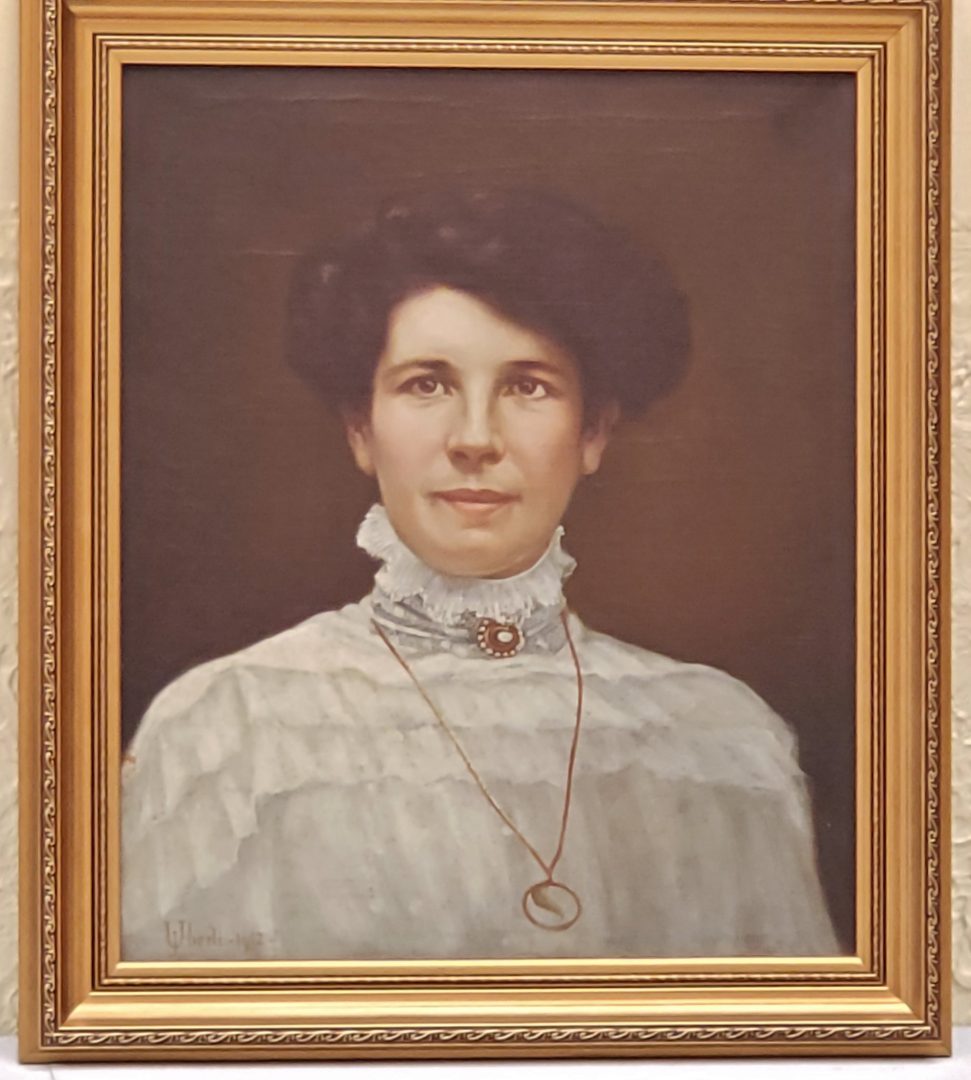Blanche Morin is depicted here at the age of 24.
She was born in Saint-Casimir in Portneuf county on November 12, 1888; she was baptized the following day under the first names Marie Anne Blanche. Her mother was Hermance Grandbois, and her father was Damase Morin, a mason. The family moved to Nicolet after the birth of Joseph Alphonse Albert (Blanche’s brother), who was born in Saint-Casimir on December 4, 1892.
Blanche met her future husband, Jules Caron (1885-1942). They got married in the Saint-Jean-Baptiste parish of Nicolet on February 6, 1911. In the 1911 Canadian census, the young couple lived on rue Brassard; it is mentioned there that Jules was a painter. A first son was born from their union on November 24, 1911: Joseph Louis Charles André. The latter died on the following January 18. It was during the year of this ordeal that the artist Giuseppe (Joseph) Uberti painted the portraits of Blanche and Jules.
The following year, the couple settled in Princeville. Their second son, Louis Jean Alphonse Joseph (1913-1983), would be born there. He would go on to study at the Séminaire Saint-Joseph and, like his father and grandfather, become an architect.
Jules Caron obtained his architecture diploma in 1914. A daughter would be born named Yvonne (1914 or 1915-1987).
In March 1936, Jules and Blanche celebrated their silver jubilee at the Château de Blois in the presence of many friends and family members.
Blanche Morin Caron died on December 13, 1977.
As for the artist, Giuseppe Uberti, he was born in Italy around 1860. He seems to have chosen to Gallicize his first name, going by Joseph shortly after settling in France.
Uberti is the author of Interior View of the Chapel of the Château de la Bastie d’Urfé, painted around 1880 before the chapel was dismantled.
In Paris, Giuseppe Uberti created the fresco St. Luke, Patron Saint of Artists and Artistic Workers, as well as several others produced around 1899 in the Notre-Dame-du-Travail church in Paris. Cécile Dupré described these paintings in Notre-Dame-du-Travail (Paris), une église au tournant du XIXe siècle et du XXe siècle (Notre-Dame-du-Travail [Paris]: A Church at the Turn of the 19th Century and the 20th Century).
Uberti’s brushwork has been described as original and vigorous.
In 1907, he accepted the invitation of architect Louis Caron, Sr. and Msgr. Joseph Simon Herman Brunault, bishop of the diocese of Nicolet, to come and visit the churches of the region. Furthermore, six canvases commissioned in 1912, which are among the jewels of the Saint-Médard church in Warwick, are works by this painter that were produced while he was in the service of the Parisian house Champigneulle, renowned for its stained-glass windows. In addition, other paintings of religious inspiration by this artist are listed in the Répertoire du patrimoine culturel du Québec maintained by the Ministry of Culture and Communications.
Uberti generally signed his canvases in an unusual way. The artist drew the letter “J” for Joseph, which weaves and intersects with the centre of the lower curve of the “U” for Uberti, before completing what resembles a fork with the rest of his last name “berti.”
The McCord Stewart Museum and the Musée national des Beaux-Arts du Québec both own works by Giuseppe / Joseph Uberti.
Donation from the estate of Jean-Louis Caron
Musée Pierre-Boucher Collection
2008 293 P
